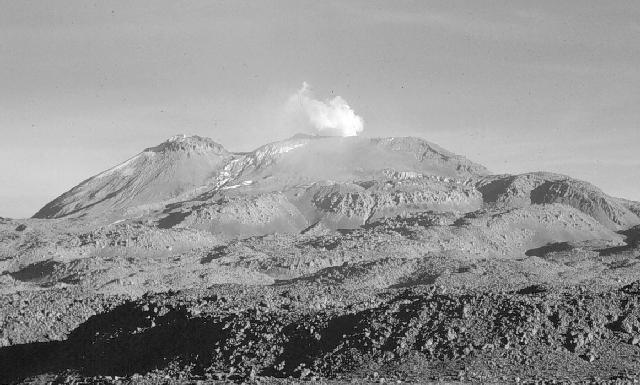Report on Sabancaya (Peru) — August 1998
Bulletin of the Global Volcanism Network, vol. 23, no. 8 (August 1998)
Managing Editor: Richard Wunderman.
Sabancaya (Peru) Increases in August gas emissions
Please cite this report as:
Global Volcanism Program, 1998. Report on Sabancaya (Peru) (Wunderman, R., ed.). Bulletin of the Global Volcanism Network, 23:8. Smithsonian Institution. https://doi.org/10.5479/si.GVP.BGVN199808-354006
Sabancaya
Peru
15.787°S, 71.857°W; summit elev. 5960 m
All times are local (unless otherwise noted)
Activity was monitored during 13-31 August using satellite remote sensing data and detailed field observations. During this time, the amount of gas being emitted from the central crater increased. At the height of emission, gas clouds from the crater rose over 1 km. Most frequently, plumes attained heights of 300-500 m before dissipating due to strong winds. However, on several occasions cumulo-type clouds formed and moved over the surrounding Pampa. Gas emissions were predominantly white in color but occasionally gray, yellow, and brown. During active phases new plumes emerged on average every 2-3 minutes. Nearly continuous venting occurred from two fumaroles on the N and S sides of the crater.
At 0640 on 16 August a pronounced increase in gas emission was observed. Dense white clouds filled the crater and formed a plume rising over 300 m. At 0645 material was seen falling from a gray/brown cloud onto the S flank of the cone. This small ash ejection lasted for a few minutes (figure 9). A noticeable decline in the emission rate occurred from 0726 until 0847, when gas clouds became infrequent. Activity continued at this reduced level into the next day. At 1355 on the 18th a yellow/brown and gray cloud rose ~800 m above the crater. Following this, activity returned to faint gas emissions. Increased activity was observed again at 1019 on the 20th when dense yellow and brown clouds were emitted. Another thick brown gas cloud emerged at 1044, after which there was a return to white emissions. Activity decreased noticeably from 1100 to 1200, by which time the gas was only faintly visible. On the 22nd at 1420 dense white clouds rose 500 m over the crater. Plumes emerged predominantly from the S side of the crater every 2-3 minutes.
 |
Figure 9. A ground view of one of the small ash eruptions at Sabancaya on 16 August at 0700 looking to the NW. Ash fell on the S side of the upper slopes of the cone. Courtesy of Mark Bulmer. |
No emissions were seen on 23 August until 1325; a large dense gas cloud emerged from the whole crater at 1510. At 1524 the cloud on the S side of the crater formed a brown plume that rose straight upwards more than 400 m. Gas clouds descended the upper S slopes of the cone at 1530. Five minutes later a light brown-white and yellow gas plume formed on the N side of the crater. Emissions continued until dusk when observations ceased. On the morning of the 24th at 0740 dark gray clouds rose slowly from the crater. At 0756 gas from the lower portion of an ascending plume moved down the upper slopes of the cone on the N side. By 0804 the color of the plumes emerging from the crater altered to white. However, at 0816 a gray/brown gas cloud emerged and dispersed <100 m above the crater. After this no further emissions were seen until 1359 when white emissions commenced, forming cumulo-type clouds that sat over Ampato. At 0700 on the 25th, dark gray and brown clouds were emitted from the center of the crater. At 0714 a white, brown, and gray cloud emerged from the middle of the crater. Emissions were light for the rest of the day.
On 26 August at 0757 a light brown-and-gray cloud emerged. Only faint emissions were noted until 0804 when a new brown and white cloud rose 300 m. The amount of gas released then diminished to very small clouds every 2-3 minutes. At 1430 gas was rising from the whole crater; activity remained at a similar level for the rest of the afternoon. At dusk, a brown haze sat over the crater. Only limited observations were possible on 28 August. Activity was first noted at 0857 when a gray cloud emerged from the S side of the crater. Gas emission was observed at 1430 but not at 1630. The next observation was at 1447 on the 31st, at which time white clouds were being emitted from the center of the crater. At 1625 the amount of gas being released appeared to increase and became grayer. Evening sunlight was seen refracted in gas clouds ~1 km above the crater, producing a rainbow effect.
Geological Summary. Sabancaya, located in the saddle NE of Ampato and SE of Hualca Hualca volcanoes, is the youngest of these volcanic centers and the only one to have erupted in historical time. The oldest of the three, Nevado Hualca Hualca, is of probable late-Pliocene to early Pleistocene age. The name Sabancaya (meaning "tongue of fire" in the Quechua language) first appeared in records in 1595 CE, suggesting activity prior to that date. Holocene activity has consisted of Plinian eruptions followed by emission of voluminous andesitic and dacitic lava flows, which form an extensive apron around the volcano on all sides but the south. Records of observed eruptions date back to 1750 CE.
Information Contacts: Mark Bulmer, Frederick Engle, and Andrew Johnston, Center for Earth and Planetary Studies, National Air and Space Museum, Smithsonian Institution, Washington DC 20560-0315.

